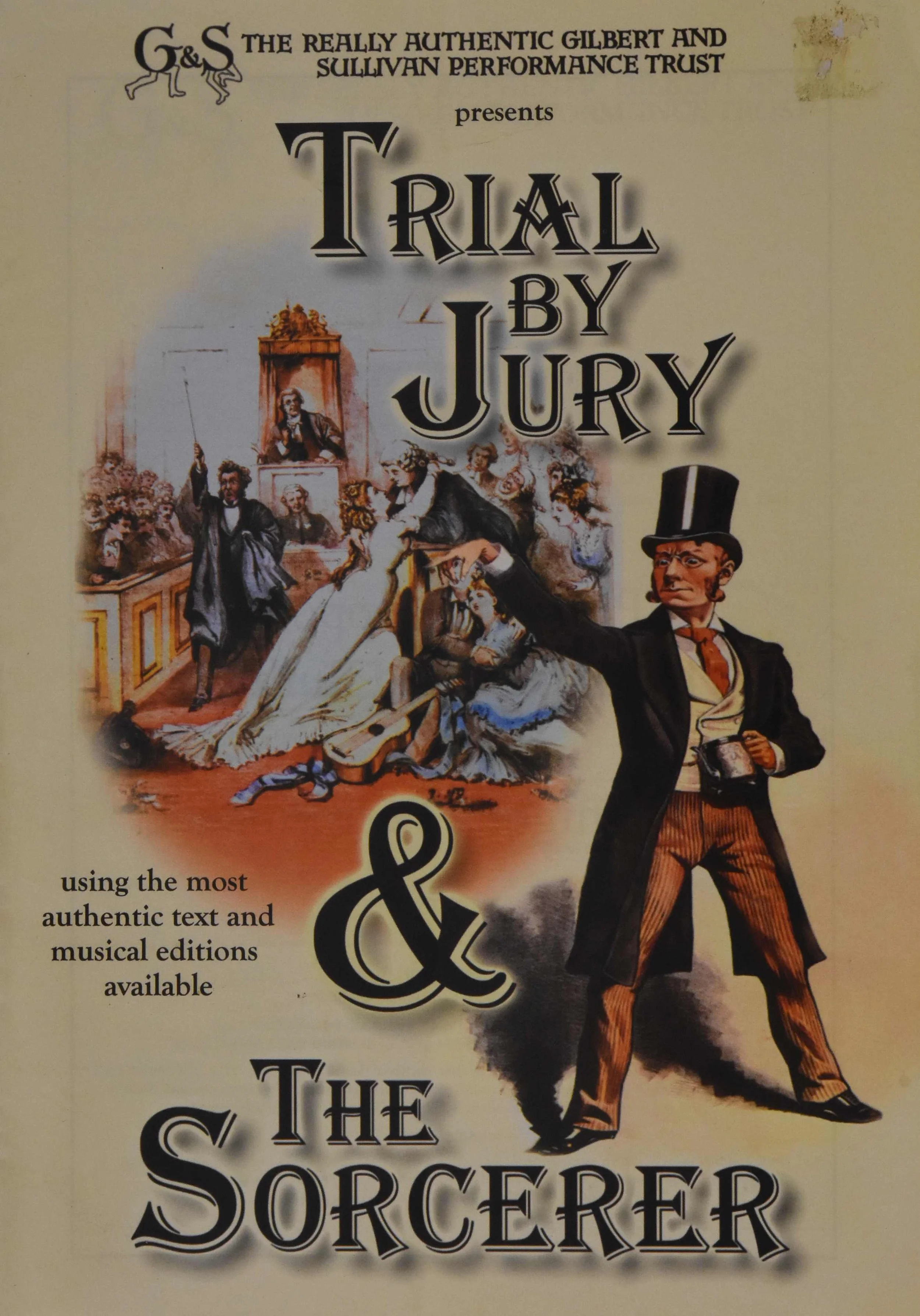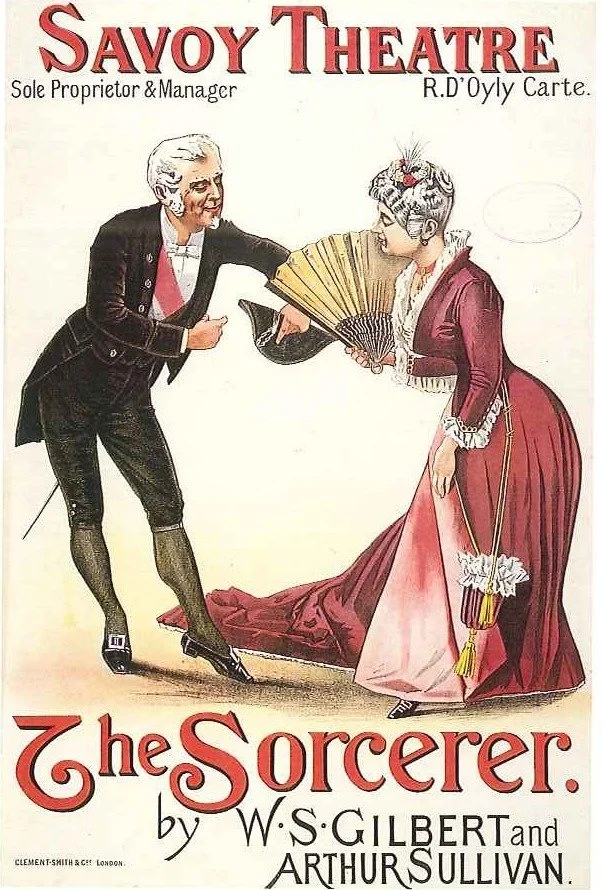Front cover of Dunedin’s Really Authentic Gilbert and Sullivan Performance Trust of 2002
The Sorcerer is the third of Gilbert and Sullivan’s operettas. This was Gilbert and Sullivan’s first full-length operetta. Wikipedia explains the plot as follows ‘it is based on a Christmas story, “An Elixir of Love” that Gilbert wrote in 1876. A young man, Alexis, of the Grenadier Guards, (at the start of the operetta, the village is celebrating the engagement of two members of the gentry, Alexis and Aline) is obsessed with the idea of love levelling all ranks and social distinctions. To promote his beliefs, he invites the proprietor of J.W. Wells and Co., Family Sorcerers, to brew a love potion. This causes everyone in the village to fall in love with the first person they see and results in the pairing of comically mismatched couples. (Those who are already married are immune to the spell). In the end, Wells must sacrifice his life to break the spell’. The setting is a small village inhabited by country people and gentry.
It first opened in London at the Opera Comique on the 17th November 1877. It ran for 178 performances which was considered a success. It was revised in 1884 for a new production and this version is the one mostly used today. Gilbert and Sullivan mostly controlled the production as well as the selection of the cast members. And as Wikipedia states ‘it was their first opera to use all the major character types and typical range of songs that would appear in their later collaborations, such as comic duets, a patter song, a contrapuntal double chorus, a tenor and soprano love duet, a soprano showpiece and so on’.
By having control of the selection of the cast members, Gilbert and Sullivan were able to chose actors who were not well-known and because of this, did not command high fees. Gilbert and Sullivan were able to write their operetta with these cast members in mind. The chorus in the Gilbert and Sullivan’s operettas could be considered as a character. The Sorcerer contains a patter song, a feature that is typical in other Gilbert and Sullivan operettas.
Lady Sangazure, a character in “The Sorcerer” was ‘the first of the macabre procession of elderly and ugly ladies- in Gilbert and Sullivan opera’. The operetta contains one of Gilbert and Sullivan’s best comic characters, John Wellington Wells. In “The Sorcerer” Gilbert and Sullivan were introducing the public to a new type of comic opera.
As was often the case, Sullivan had not composed the overture, so he used music from other pieces that he had written. There was a new overture written for the 1884 version. Often the D’Oyly Carte Opera Company played Trial by Jury with The Sorcerer.
By Unknown author - Wilson, Frederic Woodbridge (1989). An Introduction to The Gilbert and Sullivan Operas. The Pierpont Morgan Library. ISBN 87598-08880 Invalid ISBN-0., Public Domain, https://commons.wikimedia.org/w/index.php?curid=19862628
The first authorised production in Australia produced by J. C. Williamson was on the 22nd May 1886 at the Theatre Royal, Melbourne. The Sorcerer was not produced in the United States until after the phenomenal success of “H.M.S. Pinafore”. As of the 4th July 1879, “The Sorcerer” was still being played throughout the English provinces and in the United States. According to the Thames Advertiser of the same date ‘its great fun consists in representing people as acting and speaking in the most ridiculous manner, as if it were the most natural thing in the world’.
Overall, the reviews of The Sorcerer were positive. There were comments though concerning Sullivan wasting his talent and the fact that Gilbert often portrayed clergymen in a comical way.
One review in the Auckland Star on the 17th January 1878 describes the first performance at the Opera Comique Theatre on Saturday, 17th November 1877. It says that the theatre ‘was crammed from floor to ceiling by a distinguished and critical audience anxious to witness the initial performance of “The Sorcerer”. The interest of the occasion was enhanced by the fact that several of the principal performers, notably Mr Rutland Barrington and Miss Alice May, were comparatively new to the stage, and consequently “on their promotion”. Alice May, in a bewitching costume, charmed the eyes and ears of everybody. The leading idea of “The Sorcerer” can scarcely be original, but its treatment at any rate is remarkable. The London papers are unanimous in praising the production, and it will certainly enjoy a lengthened run’.
By Unknown author - Wilson, Frederic Woodbridge (1989). An Introduction to The Gilbert and Sullivan Operas. The Pierpont Morgan Library. ISBN 87598-08880 Invalid ISBN-0., Public Domain, https://commons.wikimedia.org/w/index.php?curid=19862164
The Bruce Herald dated 28th May 1878 informs their readers that ‘thanks to the public favours vouched to “The Sorcerer”, Messers Gilbert and Sullivan have agreed to write a new operetta for the Opera Comique, London, for Easter’.
The first production of “The Sorcerer” in New Zealand was on the 23rd May 1879 according to the New Zealand Herald on the 22nd May 1879. It states that the chorus will consist of between 30 and 40 voices and there will be a full orchestra. A long article in the Auckland Star on the 23rd May 1879 has the view that the public in the United Kingdom were becoming tired of the opera bouffe genre as many of them ‘strongly resembles another’. It carries on saying, ‘Mr W. S. Gilbert is without doubt the best living writer of quaint conceits and humourous versicles. His plots are of the slightest possible description, but no fault can be found with the way in which they are carried out. Mr Arthur Sullivan does them ample justice. His music, without in any way resembling opera bouffe, is full of melody and sparkling as champagne’.
A review of a production in Dunedin criticises the production saying ‘but while it is a comic opera, it has little in common with “Trial by Jury” and “H.M.S. Pinafore”. The humour is more far-fetched and strained, and therefore less effective; while the music is of a more ambitious kind, and contains scarcely a single taking air. Still, there is a vein of melody running through most of the score, and the orchestration is so masterly and in some places so novelly (sic) daring that the opera cannot but be listened to with a certain amount of pleasure’. The reviewer recommends discontinuing “The Sorcerer” and replacing it with “Trial by Jury” or something similar. It continues by saying that ‘last night’s performance was very flat, and the opera most decidedly did not hit the taste of the audience, who bore a most apathetic demeanour almost from beginning to end, being roused to anything like enthusiasm only twice – by the magnificent finale to the first act, and by Mr Daly’s air “Engaged to so-and-so”’.
The Evening Post on the 25th September 1879 has a more favourable review of the English Opera Company’s production of “The Sorcerer” at the Academy of Music in Wellington. It states ‘the work is in every way a delightful one. The music is charming, superior even to that of “H.M.S. Pinafore” in its character, but with similarly pretty and taking melodies, while in many cases some very fine and massive effects of harmony are produced, notably in the grand finale of the first act. It was one of the most exquisite pieces of part-singing ever yet heard in Wellington. The plot is thoroughly coherent and interesting, although intensely ludicrous. “The Sorcerer” will be repeated tonight, and we strongly recommend all who enjoy fine music, sparkling wit and a hearty laugh, not to lose the opportunity of hearing and seeing it’.
Above come from the Auckland Star 15th July 1879 and the Thames Advertiser 30th April 1881.
The Wanganui Chronicle on the 10th October 1879 tells that Mr Carey (sic – should be Cary, there is another post about this person) has arrived on the Stormbird from Wellington’ to make arrangements for a brief season in Wanganui of one of the most popular companies in opera bouffe that has ever appeared before a new Zealand public. The company will open on this night week with “H.M.S. Pinafore” which has produced quite a sensation wherever it has been performed. On the second night the company will appear in “The Sorcerer”, one of Gilbert and Sullivan’s masterpieces, to be followed by “Girofle-Girofla”, “Maritana”, and “Trial by Jury”, “Pinafore being repeated on the last night’.
The above are from the Colonist 9th October 1879, the Nelson Mail 9th October 1879 and the Wanganui Chronicle 20th October 1879.
According to the Thames Star on the 6th May 1881 ‘unlike “Pinafore”, which revels in “taking” airs and easily remembered choruses, “The Sorcerer” is much more classical in style, and few solos are of such effective character as those in Sullivan’s chef d’oeuvre’. The composer has, in several instances introduced harmonious discords such as only the accomplished musician can understand. These discords, being necessarily of different notes in close combination, are most difficult for vocalists unused to such music effects, and in the chorus “O Marvellous Illusion”, the general rendering terminates in a most harmonious jumble. Even though the discordant phrases are correctly interpreted, the mass fail to understand or appreciate them, and when imperfectly sung they are most apt to excite a feeling of disgust and derision in the minds of the audience’.
Henry Lytton, Elsie Griffin and Derek Oldham in The Sorcerer, 1920
By Unknown author - http://pinafore.www3.50megs.com/hlysor01.html, Public Domain, https://commons.wikimedia.org/w/index.php?curid=32806654
In the Otago Witness on the 22nd October 1881 it informs their readers that ‘Mr Cary has been getting into hot water in Wellington. As a windup of his season there he produced “The Sorcerer”, and he appears to have repeated his Dunedin mistake of attempting to play a piece after inadequate rehearsal’. It goes on to states that in the Wellington production many cast members did not know their parts. And it continues, ‘Mr Wentworth, who appeared as the Vicar, had not the remotest conception of the part, both his acting and make-up leading one rather to suppose that he was representing an habitual criminal disguised in clerical attire for larcenous purposes. At any rate, no one would have taken him for the grave and dignified vicar of a quiet country village. Mr Barry O’Neill, who came on as Mr J. W. Wells, sang the Sorcerer’s song – or at least as much as he could remember – as if it were a music-hall ditty of the ‘motto’ order. The whole piece betrayed a want of care in its production that was very unfavourable to Mr Cary’. Cary was on stage one evening to answer the press criticism. He stated that he had last £80 on the Wellington production. He considered that the critics were to blame for the small audiences.
And again the Cary Opera Bouffe Troupe when playing in Auckland in Auckland on the 22nd November 1881 came in for similar criticism. The Auckland Star dated the 22nd November 1881 states that the performance of “The Sorcerer” was indifferent, most probably due to insufficient rehearsal. It says ‘the hastiness of preparation was particularly evident from the manner in which the choruses went, as well as from the general execution of the orchestra. The concluding chorus of the first act was decidedly faulty and the time was badly observed throughout’. The New Zealand Herald of the same date states ‘there was a good deal of ad libitum fun, acting, and singing, which being spontaneous, sustained the character of the piece as a burlesque, and received very marked applause’. It goes on to say that ‘ the orchestra was a great deal too loud, and the accompaniments were not always favourable to the singer’.
In the Otago Witness on the 23rd December 1882 it laments that ‘“The Sorcerer” has been revived at the Bijou, New York with great success. It is singular that this particular one of Gilbert and Sullivan’s operas, which is brilliant in its way, is not oftener produced”.
One comment in the Evening Post on the 25th May 1882 is that “The Sorcerer” is ‘the least generally successful, its wit and point being perhaps over-refined for the multitude’.
One review in the South Canterbury Times on the 19th December 1882 begins by saying ‘Gilbert and Sullivan have provided operas which carry no weight, but it is within the reach of many to shine in them. They share the defect common to all comic operas, their plot is flimsy and it is woven upon good music and therefore the lover of music is placed in this positions, he must see the opera half-a-dozen times and get thoroughly sick of the nonsensical plot, before he is in a position to give his undivided attention to the music’ it goes on to comment that ‘of the manner in which the opera was played, it may be said that it was characterised by correctness rather than spirit. There was distinctly apparent a certain stiffness and a general want of the abandon which is an absolute sine qua non in comic opera. There was want of precision and in ease in the movements of some of the characters, and a little confusion occurred now and then and some of the chorus narrowly escaped cannoning with their companions. The music of this opera is not striking, but it grows upon one and is really beautiful’.
The Otago Daily Times of the 13th June 1885 explains ‘”The Sorcerer” is a more ambitious and therefore heavier opera than “Pinafore”. The plot of “The Sorcerer” is as amusing as “Pinafore” but the airs are not so catchy, to use a popular word’.
The New Zealand Herald notes on the 19th August 1885 that the music of “The Sorcerer” makes great demands on the orchestra and chorus which, according to the writer, is the reason why it hasn’t been played by recent visiting companies.
www.en.wikipedia.org/wiki/The_Sorcerer
The Gilbert and Sullivan Book Leslie Baily published by Spring Books 1967










